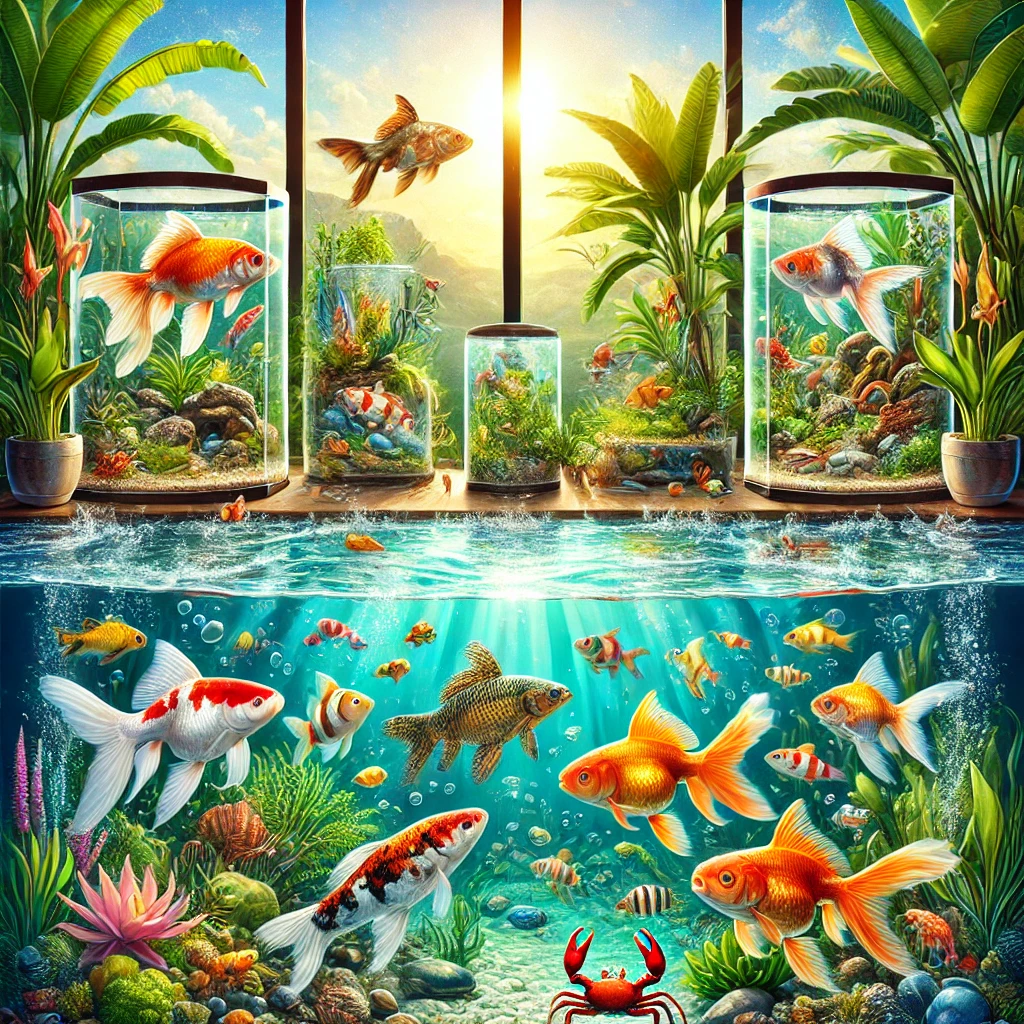Bulldogs and Their Delusional Speed: The Sprint That Never Was If you’ve ever watched a bulldog play, you’ve probably noticed something utterly hilarious. they...
Care guide for taking care of Aquatic Pets: Important things You Need to Know
There’s something interesting about aquatic animals. Whether it’s a vibrant beta fish swimming elegantly in a well-kept tank, a turtle basking under a warm heat lamp while having their legs sticking out on a large rock or platform, or even a goldfish circling the water in a garden pond, these water-based animals bring a sense of peace and curiosity. But keeping them happy and healthy takes more than just water and food, each species of these animals have unique needs that must be met for them to thrive in certain environments.
So, whether you’re a first-time fish owner or considering adding more exotic aquatic creatures to your tanks or ponds at home, this guide will teach the basics to aquatic animal care. Let’s dive into the basics of care for your water companion, their dietary needs, enrichment, and how to create the perfect environment for them to be able to live long happy lives!
Understanding Aquatic Pets and Their Needs
Aquatic pets aren’t a one-size-fits-all deal. There are fish, amphibians, crustaceans, turtles, and even larger pond or marine animals, each with their own specific needs that need to be met, it’s also good to do extensive forms of research on your aquatic pets, to give yourself more knowledge about them and it shows that you care for their future.
✔ Tanks or Open Water: Are you keeping your pet in a tank, a pond, or a more open environment? The level of care differs significantly depending on the space that’s provided or can be provided.
✔ Water Conditions Matter: Freshwater, saltwater, cold, warm or room temp. Each species thrives in specific water temperatures and conditions that must be carefully maintained.
✔ Lifespan & Commitment: Some aquatic pets, like goldfish are easy to manage and with proper care can live up to 10-15 years. While others (like turtles or koi) can live for decades. Turtles being able to live up to 20-30 years while koi can live for 25-35 years, taking proper care of them will help them live for longer periods of time.
Setting Up the Perfect Habitat
Before getting any aquatic pet, it’s crucial to set up their home properly so they don’t get hurt and there doesn’t become a potential issue for you and your aquatic companions.
For Tank-Dwelling Pets (Fish, Turtles, Frogs, Shrimp, etc.)
- Choose the Right Size Tank: Many beginner aquatic pet owners make the mistake of keeping pets in tanks that are too small for them. Do research and learn how much space your pet needs to grow, bigger is almost always better for development.
- Filtration & Water Quality: A good filter in the tank or pond keeps the water clean by removing waste and toxins from the environment, just enough that the waste and toxins don’t hurt your pets. Regular water changes (about 25% per week but can vary depending on the number of companions you keep) help maintain healthy tank and pet conditions.
- Water Temperature & pH: Different species have specific needs for how cold, warm or room temperature their watery homes conditions are.
- Tropical fish: (bettas, tetras, angelfish and more.) need heated tanks. (75-80/82°F).
- Coldwater fish: (goldfish, koi and more) prefer much cooler conditions. (65-75°F).
- Amphibians & turtles: need both water and land or high-raised areas with heat lamps.
- Tropical fish: (bettas, tetras, angelfish and more.) need heated tanks. (75-80/82°F).
- Substrate & Decorations: Gravel, sand, rocks, and real or fake plants help mimic the natural environments and will help make aquatic pets feel safe. Some species, like shrimp, love hiding spots, while others, like bettas, need calmer, open swimming spaces to spread their fins.
- Lighting & UVB (for reptiles & amphibians): Some animals, like turtles and frogs, need UVB lighting to keep their body temperatures regulated, they also help to process calcium and prevent health issues like metabolic bone disease.
For Open Environments (Ponds, Lakes, & Large Setups)
- Pond Size & Depth: Koi and goldfish need large, deep ponds to survive the changing seasons and changing water temperatures, meaning a larger pond allows for better water quality and helps them survive colder conditions by providing space to access areas with more dissolved oxygen for them.
- Natural Filtration: Plants, rocks, and good bacteria help keep the water clean. Some people use filtration systems for their pets, while others rely on a more natural balance in the watery environments.
- Aeration: Bubblers, waterfalls, or fountains help keep oxygen levels high on the environment, so that your aquatic companions can breathe.
- Predator Protection: Outdoor pets may be at risk from birds, raccoons, or other animals. Mesh and other forms of covering or deeper water for hiding in will help keep them safe from getting scooped up.
Nourishment: What Do Aquatic Pets Eat?
Feeding aquatic pets aren’t just about tossing in random food, each species has unique dietary requirements that work differently from one another.
Fish
🐠 Carnivores (betta fish, cichlids, arowanas): Need protein-rich diets like bloodworms, brine shrimp, high-quality pellets, flakes, krill, worms, and more for their diets.
🐠 Herbivores (plecos, goldfish, koi): Prefer algae wafers, blanched veggies (zucchini, spinach), plant-based flakes, insects and more.
🐠 Omnivores (tetras, guppies, angelfish): Thrive on a mix of pellets, flakes, and occasional live or frozen food and other edible live or plant based foods.
Turtles
🐢 Aquatic turtles: need a mix of pellets, leafy greens and plants, fruits, and occasional protein like mealworms or fish, putting a cuttlebone in the tank helps keep their shells strong and gives calcium.
Amphibians (Frogs, Salamanders, Axolotls)
🦎 Live food is key: They mostly eat worms, insects, and small feeder fish. Axolotls, in particular, love bloodworms and sinking pellets.
Shrimp, Crabs, and Snails
🦐 Scavengers: These companions help clean up tanks by eating algae, decaying plants, fish food and other leftovers, but they still need balanced diets with sinking pellets and calcium supplements to keep their shells and exoskeletons strong.
Entertainment & Enrichment for Aquatic Pets
Keeping aquatic pets entertained is just as important as feeding them, and keeps them mentally stimulated like any other animal. Bored pets can become stressed, lethargic, or even aggressive towards other pond or tank-mates. Here’s how to keep them stimulated and happy.
For Fish:
🎾 Floating Toys & Mirrors: Bettas, in particular, show some interest in looking at their reflections. A small mirror for a few minutes a day can keep them engaged, by giving them a bit of a ‘workout’ through flaring their fins.
🌿 Live Plants & Hiding Spaces: Adding plants like anacharis, java fern, moss balls or other plant life to your ponds or tanks, provides hiding spots and mental stimulation. Plants also provide a food source, habitat, removal of carbon dioxide and production of oxygen through photosynthesis.
🥏 Training with Food: Some fish and other aquatic creatures, can learn how to do tricks! you can use food to guide them through hoops, Following a finger, Eat from your hand, Jump out of water, Come up to be petted or held and doing an obstacle course that you create for them.
For Turtles & Amphibians:
🏀 Floating Logs & Platforms: Turtles love climbing, so providing different basking spots for them adds variety to their basking and climbing routine.
🔦 Laser Pointer Fun: some pets react to small lights moving around, making it a fun game and stimulating their responses through play.
🐌 Live Feeder Challenges: Dropping live food like worms or fish into the tank encourages natural hunting instincts and exercise for fins and toes.
For Shrimp, Crabs & Snails:
🏕 Caves & Hiding Spots: Crabs and shrimp love small caves, tunnels, and even coconut shells to explore and make little hiding spots out of, even swim or crawl through.
🛠 Puzzle Feeding: Hiding food in different spots around the tank makes foraging fun and encourages movement, mental stimulation and workouts for your aquatic pets, keeping them happy and motivated to find food.
Final Thoughts on companion care
Caring for aquatic pets is both an art and a science. Whether you have a small beta in a tank or a thriving koi pond in your backyard, the key to success in keeping your pets thriving in the environment, is understanding their specific needs and providing the best environment possible, using enrichment so they can stay motivated and get different forms of exercises.
With the right balance of clean water, proper nourishment, entertainment, and regular environment maintenance, your aquatic pets will live long, happy, and healthy lives in their homes. And trust me, there’s nothing quite as rewarding as watching them swimming or sitting around their homes thriving and happy.





